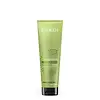What's inside
What's inside
 Key Ingredients
Key Ingredients

No key ingredients
 Benefits
Benefits

 Concerns
Concerns

 Ingredients Side-by-side
Ingredients Side-by-side

Water
Skin ConditioningCetearyl Alcohol
EmollientCetyl Esters
EmollientAmodimethicone
Behentrimonium Chloride
PreservativePhenoxyethanol
PreservativeParfum
MaskingSorbitol
HumectantIsopropyl Alcohol
SolventTrideceth-6
EmulsifyingHydrolyzed Soy Protein
HumectantMoringa Oleifera Seed Oil
EmollientHydrolyzed Vegetable Protein Pg-Propyl Silanetriol
Skin ConditioningArginine
MaskingCitric Acid
BufferingCetrimonium Chloride
AntimicrobialChlorhexidine Dihydrochloride
AntimicrobialHexyl Cinnamal
PerfumingLinalool
PerfumingEthylhexyl Methoxycinnamate
UV AbsorberLimonene
PerfumingCoumarin
PerfumingBenzyl Alcohol
PerfumingWater, Cetearyl Alcohol, Cetyl Esters, Amodimethicone, Behentrimonium Chloride, Phenoxyethanol, Parfum, Sorbitol, Isopropyl Alcohol, Trideceth-6, Hydrolyzed Soy Protein, Moringa Oleifera Seed Oil, Hydrolyzed Vegetable Protein Pg-Propyl Silanetriol, Arginine, Citric Acid, Cetrimonium Chloride, Chlorhexidine Dihydrochloride, Hexyl Cinnamal, Linalool, Ethylhexyl Methoxycinnamate, Limonene, Coumarin, Benzyl Alcohol
Water
Skin ConditioningPropylene Glycol
HumectantDimethicone
EmollientPhenoxyethanol
PreservativePolyquaternium-11
Guar Hydroxypropyltrimonium Chloride
Skin ConditioningCetyl Alcohol
EmollientParfum
MaskingHydroxypropyl Guar
Emulsion StabilisingCaprylyl Glycol
EmollientCeteth-10 Phosphate
CleansingStyrene/Acrylates Copolymer
Laureth-4
EmulsifyingLaureth-23
CleansingHydrolyzed Soy Protein
HumectantBenzophenone-4
UV AbsorberDisodium EDTA
Sodium Citrate
BufferingHydrolyzed Vegetable Protein
Skin ConditioningCystine Bis-Pg-Propyl Silanetriol
Skin ConditioningArginine
MaskingHexyl Cinnamal
PerfumingSodium Chloride
MaskingLinalool
PerfumingPotassium PCA
HumectantDisodium Laureth Sulfosuccinate
CleansingTocopherol
AntioxidantWater, Propylene Glycol, Dimethicone, Phenoxyethanol, Polyquaternium-11, Guar Hydroxypropyltrimonium Chloride, Cetyl Alcohol, Parfum, Hydroxypropyl Guar, Caprylyl Glycol, Ceteth-10 Phosphate, Styrene/Acrylates Copolymer, Laureth-4, Laureth-23, Hydrolyzed Soy Protein, Benzophenone-4, Disodium EDTA, Sodium Citrate, Hydrolyzed Vegetable Protein, Cystine Bis-Pg-Propyl Silanetriol, Arginine, Hexyl Cinnamal, Sodium Chloride, Linalool, Potassium PCA, Disodium Laureth Sulfosuccinate, Tocopherol
Ingredients Explained
These ingredients are found in both products.
Ingredients higher up in an ingredient list are typically present in a larger amount.
Arginine is an amino acid that is important for human development. Your body uses is it to produce hair keratin and skin collagen.
As a cosmetic ingredient, Arginine has antioxidant properties and can also help repair damaged skin. This ingredient is derived either synthetically or from animals.
Arginine isn't fungal acne safe when used in the presence of other lipids (fats, fatty acids, oils, esters, etc). Oils and fats occur naturally within the skin, so take caution when using Arginine if you're prone to fungal acne.
Learn more about ArginineHexyl Cinnamal is a fragrance ingredient with a similar scent to jasmine. It can be naturally found in chamomile essential oil.
This ingredient is a known EU allergen and may sensitize the skin. The EU requires this ingredient to be listed separately on an ingredients list.
Hexyl Cinnamal is not water soluble but is soluble in oils.
Learn more about Hexyl CinnamalHydrolyzed Soy Protein is a vegan protein made to mimic hydrolyzed collagen. It is created from soy, or glycine soja.
This ingredient is a humectant, meaning it helps hydrate the skin by binding to water. According to a manufacturer, it is also a great hair conditioner.
Read more about hydrolyzed collagen here.
Learn more about Hydrolyzed Soy ProteinLinalool is a fragrance and helps add scent to products. It's derived from common plants such as cinnamon, mint, citrus, and lavender.
Like Limonene, this ingredient oxidizes when exposed to air. Oxidized linalool can cause allergies and skin sensitivity.
This ingredient has a scent that is floral, spicy tropical, and citrus-like.
Learn more about LinaloolParfum is a catch-all term for an ingredient or more that is used to give a scent to products.
Also called "fragrance", this ingredient can be a blend of hundreds of chemicals or plant oils. This means every product with "fragrance" or "parfum" in the ingredients list is a different mixture.
For instance, Habanolide is a proprietary trade name for a specific aroma chemical. When used as a fragrance ingredient in cosmetics, most aroma chemicals fall under the broad labeling category of “FRAGRANCE” or “PARFUM” according to EU and US regulations.
The term 'parfum' or 'fragrance' is not regulated in many countries. In many cases, it is up to the brand to define this term.
For instance, many brands choose to label themselves as "fragrance-free" because they are not using synthetic fragrances. However, their products may still contain ingredients such as essential oils that are considered a fragrance by INCI standards.
One example is Calendula flower extract. Calendula is an essential oil that still imparts a scent or 'fragrance'.
Depending on the blend, the ingredients in the mixture can cause allergies and sensitivities on the skin. Some ingredients that are known EU allergens include linalool and citronellol.
Parfum can also be used to mask or cover an unpleasant scent.
The bottom line is: not all fragrances/parfum/ingredients are created equally. If you are worried about fragrances, we recommend taking a closer look at an ingredient. And of course, we always recommend speaking with a professional.
Learn more about ParfumPhenoxyethanol is a preservative that has germicide, antimicrobial, and aromatic properties. Studies show that phenoxyethanol can prevent microbial growth. By itself, it has a scent that is similar to that of a rose.
It's often used in formulations along with Caprylyl Glycol to preserve the shelf life of products.
Water. It's the most common cosmetic ingredient of all. You'll usually see it at the top of ingredient lists, meaning that it makes up the largest part of the product.
So why is it so popular? Water most often acts as a solvent - this means that it helps dissolve other ingredients into the formulation.
You'll also recognize water as that liquid we all need to stay alive. If you see this, drink a glass of water. Stay hydrated!
Learn more about Water